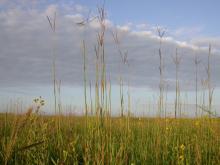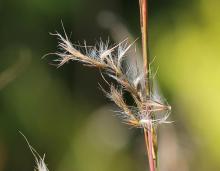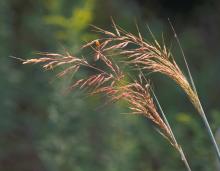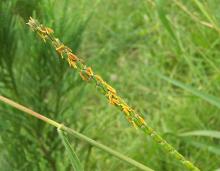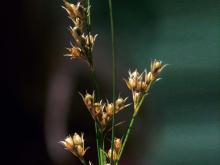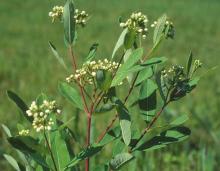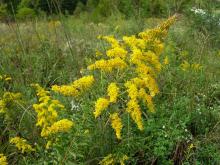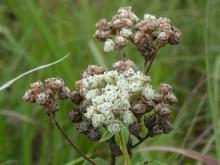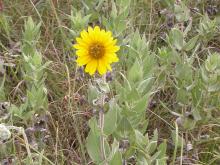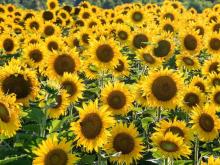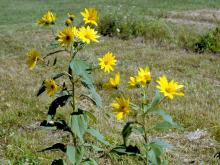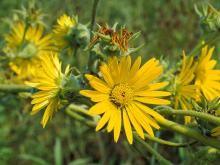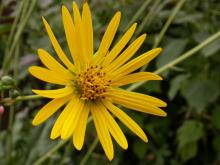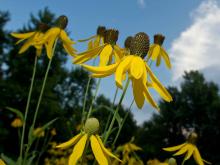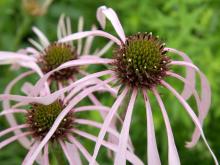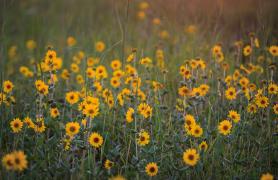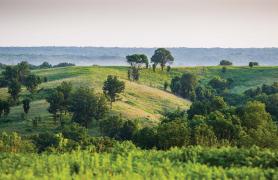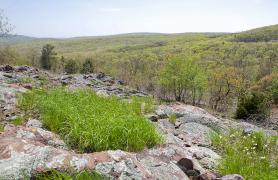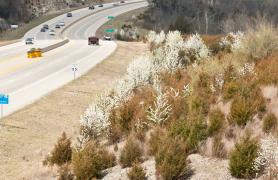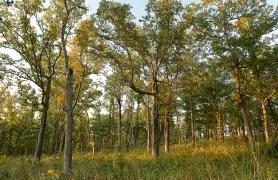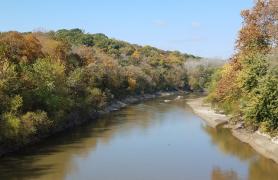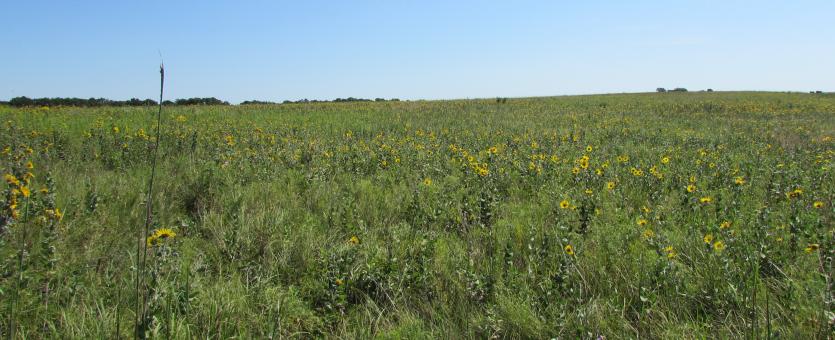
Grasslands, obviously, are grassy, open areas with few trees or none. Missouri has lots of land that fits this category, but these places are absolutely not all alike. How do ecologists distinguish among them?
Altered Versus Native Grasslands
One big distinction is between altered habitats and those that are native grasslands, not substantially changed from the way they were before European settlers altered the landscape.
Altered Grasslands
By far the largest percentage of Missouri’s grasslands are of the altered type. These include pastures, old fields, and the strips of land along highways and railroads. Most of these areas are dominated by introduced, usually nonnative grasses and forbs, which many people call weeds or wildflowers.
Many of these altered lands used to be native tallgrass prairie, especially in northern and western Missouri, but plowing destroyed the original prairie plants, and people planted fescue and other grasses for cattle. Most of the grasses that dominate pastures and old fields are cool-season grasses, which turn green and grow quickly in springtime, then dry and go dormant in our hot, droughty summers, and then renew growth again in fall’s return to cooler weather.
Most pastures, old fields, and other altered grasslands might look wild, but from an ecologist’s perspective, they amount to a landscape of nonnative, rapid-growing plants. To many species of grassland wildlife, these fields cannot offer the richly varied food sources, nesting sites, and shelter they would get from native grasslands.
Native Grasslands
Missouri has only a tiny percentage of native grasslands remaining — in Missouri, and on our entire continent. In our state, there are two main types of native grasslands: prairie and savanna. The difference between the two is based on the percent of land covered by trees. Prairies have virtually no tree cover (less than 10 percent), and savannas have less than 30 percent tree cover. Prairies and savannas often occur alongside each other, one merging gradually with the next.
The ground cover of both prairies and savannas is dominated by native warm-season grasses, such as big and little bluestem, Indian grass, and sideoats grama. Warm-season grasses are beautifully adapted to Missouri's climate. Chemical processes allow them to photosynthesize most efficiently during the hottest, driest months — so they are green, lush, and growing vigorously in midsummer while cool-season grasses go dormant.
Compared to nonnative grasslands, savannas have a staggering diversity of plant species, even on a relatively small patch of land. Counting both grasses and forbs, a 100-acre, high-quality remnant of native prairie can support at least 200 native plant species, with as many as 20 species growing within a single square yard of ground.
So many types of plants support a large variety of animals. In fact, many plants and animals that live on native prairies and savannas cannot live anywhere else on earth. Each remaining fragment of native grassland protects a vast diversity of plant and animal species, many of which are endangered. Examples range from Mead’s milkweed to the greater prairie-chicken. This natural-community connection is one very important reason for prairie and savanna conservation.
Learn to See Grasslands
With a little practice, you can learn to recognize the distinctive look of a prairie even from the road. In the hot middle of summer, prairies will be green and streaked with the colors and textures of their many different grasses and wildflowers.
Savannas have many of the same plant species as prairies, but with their scattered trees, they have a parklike look. They often occur as openings in woodlands or on cool, moist slopes amid prairieland.
What Makes Prairies and Savannas?
Why are prairies and savannas where they are? What makes them? As with all habitat types, it takes a combination of factors.
The Big Picture
Missouri occurs just to the east of the Great Plains of North America, one of the world’s greatest grasslands. This eastern reach of the Great Plains has the tallest grasses. As you move westward, the average size of the grasses decreases. That’s why we call our types of prairie tallgrass prairies, while the ones to our west (Kansas, Nebraska, the Dakotas, and beyond) are called midgrass or mixed-grass and, farther west, shortgrass prairies. The main difference is moisture: our climate is wetter, supporting more and taller vegetation than the drier lands to our west.
Moving east across America, as moisture increases, the grasslands eventually transform into wooded areas, typical of the eastern United States. Missouri is part of a transition zone, and our natural habitats range from virtually treeless prairie through true forest, which is 100 percent covered by tree canopy. A complex patchwork of intermediate habitats — savannas, glades, and woodlands — form the transition zones between the two extremes, based on varying soil depths, rock types, elevation, slope, angle to the sun, water drainage patterns, and so on.
Periodic Disturbance Keeps Prairies And Savannas Open
With the amount of moisture available in Missouri, much of the state's landscape, if left alone, would eventually turn into forest. First the cedars, sumacs, honey locusts, and other pioneer tree species appear. Then oaks, hickories, maples, and other slower-growing trees eventually take over.
However, for thousands of years — since about the end of the last ice age — both natural and human-caused disturbances have kept tallgrass prairies open. Native grasses are adapted to grazing by the American bison, also known as buffalo, and the grazing and trampling by former vast herds of these animals played a role in keeping wooded plants from becoming established. But fire is the most important factor in the long-term maintenance of prairies, savannas, and woodlands.
Native Americans long ago learned to manage grasslands for buffalo by using fire. Perhaps they learned to do this by observing prairie fires that had been started accidentally from a campfire, or by a lightning strike, and noting the effects it had.
Native Americans also knew that burning the grasses during the dormant season made travel and hunting easier. It also stimulated the plants to produce new growth, which was good for the grazing animals they hunted. Burning grasses on purpose also created open, low-fuel areas less likely to catch fire near habitations.
For thousands of years, fire kept the prairies from becoming wooded. The species that live on native prairie lands are adapted to occasional fires.
Savannas developed on areas near prairies where trees were able to make a toehold and remain — on slopes facing northeast, where it was slightly moister and cooler, for example. Even though fires occasionally sweep through savannas and kill young wooded plants, a handful of trees survive to reach a size that enables them to withstand the fires. Woodlands, too, experience fires that reduce the understory of small woody trees and shrubs, maintain a grassy ground cover, and fail to eliminate the largest trees.
Plants and Animals
Many plants and animals that live in open, sunny, grassy areas can live in both altered and native grasslands.
Grassland Animals
Wide-ranging animals like mammals, birds, and insects often can move about among various open, grassy habitats. Examples of animals that can live in almost any grassy, open area include black-and-yellow garden spider, differential grasshopper, great spangled fritillary butterfly, dickcissel, bobolink, brown-headed cowbird, scissor-tailed flycatcher, eastern cottontail, and coyote.
But animals that are tied to certain plant species or environmental conditions found only on tallgrass prairies or savannas can survive and thrive only on those natural communities. Examples of prairie specialists include the regal fritillary butterfly, pink katydid, grasshopper, Henslow’s sparrows, and greater prairie-chicken.
Many native prairie species are interconnected so closely that the disappearance of one could mean the end of others. The grassland (or prairie) crayfish, for instance, builds burrows into the ground that can be 6 feet deep. These burrows give northern crawfish frogs and other animals cool retreats during hot, dry weather.
Grassland Plants
Plants of Native Prairies and Savannas
The dominant plants on native prairies and savannas are warm-season grasses, mainly big and little bluestem, Indian grass, and sideoats grama are the superstars. Their chemical pathways for photosynthesis make them especially efficient for harvesting the sun’s energy in midsummer.
Native forbs (wildflowers and other broadleaf nonwoody plants, excluding the grasses, sedges, and rushes) that characteristically occur in prairie and savanna habitats include the following:
- Aster family: American feverfew, Ashy sunflower, compass plant, coneflowers, blazing stars, prairie dock, and purple-headed sneezeweed.
- Pea family: goat’s rue, long-bracted wild indigo, purple prairie clover, sensitive briar, white wild indigo, and leadplant.
- Milkweeds: butterfly weed, green-flowered milkweed, Mead’s milkweed, prairie milkweed, whorled milkweed
- Also: blue-eyed grass, celestial lily, closed gentian, field milkwort, hoary puccoon, Indian paintbrush, prairie alum root, prairie parsley, rattlesnake master, rose gentian, wild hyacinth, wood betony, yarrow — and many, many more.
Plants of Altered Grassy Areas
Grasses common in altered grassy areas include tall fescue, orchard grass, smooth brome, reed canary grass, Kentucky bluegrass, Timothy, broomsedge, and Johnson grass. Many of these are cool-season species, doing most of their growth during spring and fall, and many are not native to North America.
Forbs that characteristically occur in altered grassy areas are often the same types that commonly appear as weeds in gardens and croplands. Some are even invasive, and many are nonnatives. Forbs of disturbed grassy areas include the following:
- Aster family: bitterweed, bull thistle, Canada thistle, common sunflower, giant ragweed, horseweed, musk thistle, ox-eye daisy, western goat’s beard, and white snakeroot
- Pea family: crown vetch, bird’s foot trefoil, white and yellow sweet clovers, black medick
- Milkweeds: common milkweed, purple milkweed, sand vine
- Also: common horse gentian, common water hemlock, field cress, garlic mustard, hedge parsley, henbit, hogwort, horse nettle, ironweeds, leafy spurge, moth mullein, mullein, Queen Anne’s lace, self-heal, soapwort, teasels, tick trefoils, yellow rocket — and many, many more.
Missouri's native prairies used to spread across nearly all of the northern and western parts of the state. However, much of this land has been converted to cropland. Native savannas used to occur in these regions, too, as well as in the rest of the state. Altered grasslands (pastures, hay meadows, old fields, grassy roadsides, and so on) occur statewide.
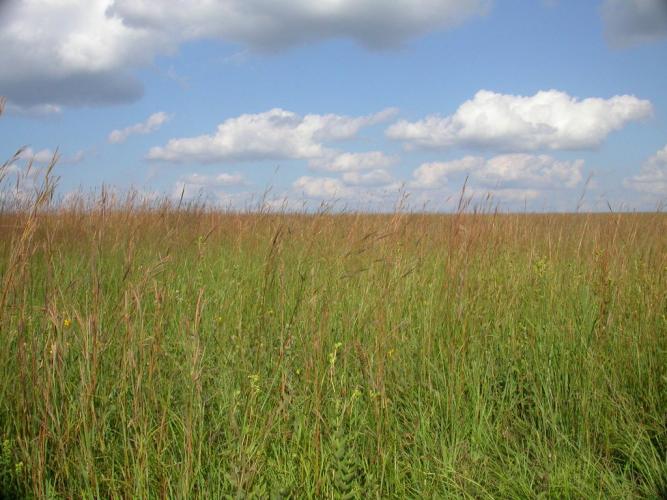
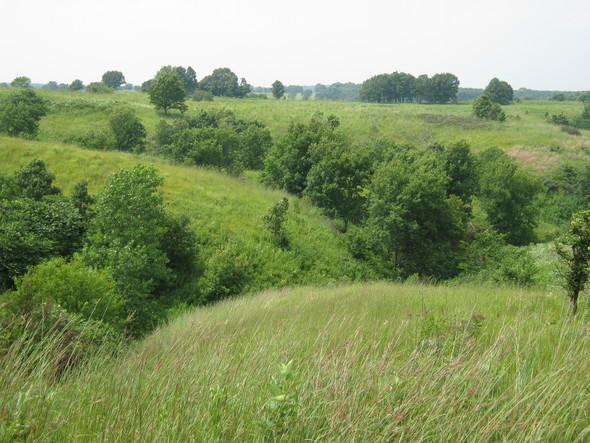
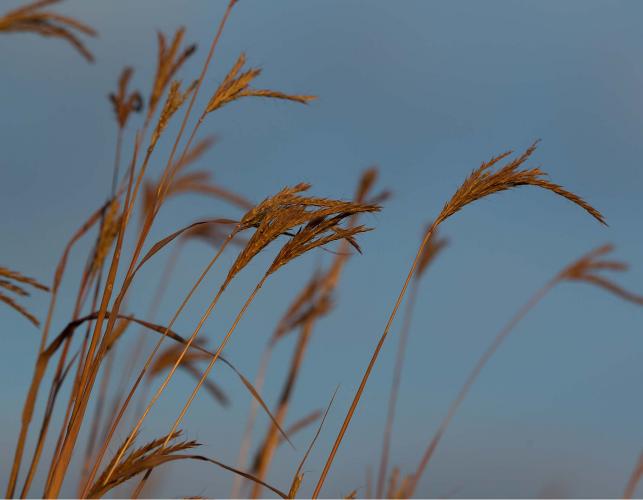
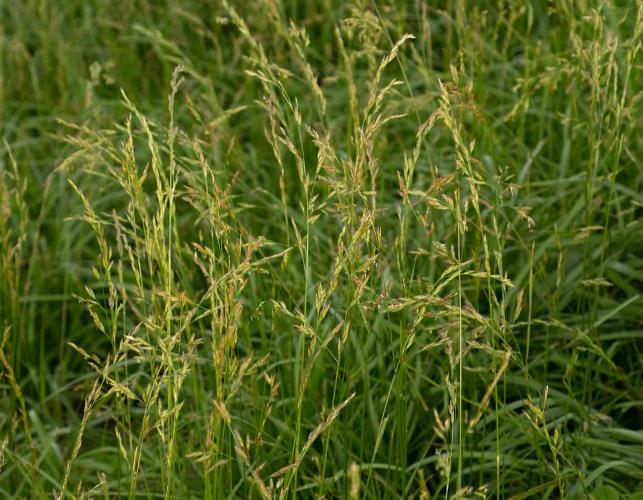
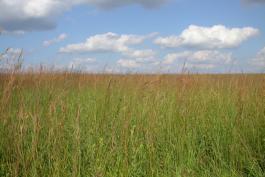
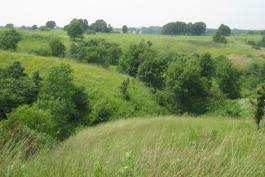
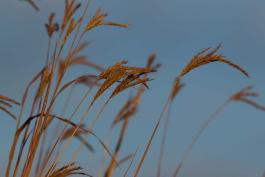
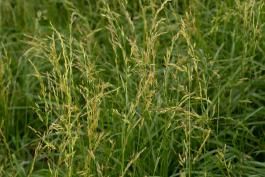
Key species

